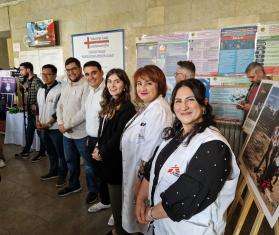With tuberculosis (TB) killing 1.7 million people and newly infecting nine million each year, this curable disease is far from being curbed. The HIV/AIDS pandemic exacerbates TB's scourge through co-infection, as does the increasing emergence of drug-resistant TB. The standard TB treatment available today is long and complex. It relies on drugs developed over forty years ago and takes six months for patients to complete, and the last four decades have brought nothing in the way of improvement.
Yet after this standstill, alternative models of drug development have recently emerged and are making inroads into improving TB treatment. Some companies have also re-engaged in this field. But it is questionable whether the efforts currently underway will be enough to provide a revolution in TB treatment that will be needed in the long term to put an end to the toll the disease takes. Dramatically reigning in TB will take much greater investment to ensure that the expanded knowledge of basic TB science is seen through to new drug development.
A Fuller Drug Pipeline — But Will it be Enough?
Thanks to alternative research and development (R&D) models, compared to just five years ago, the TB drug pipeline contains several promising compounds. The TB Alliance, a product development partnership (PDP) funded mainly by the Bill & Melinda Gates Foundation, has played an important role in this, and is associated with roughly half of the drug compounds in the pipeline today.
At the same time, increased public awareness about the lack of R&D for diseases that primarily affect developing countries has prompted some pharmaceutical companies to carry out TB drug R&D on a "no-profit-no-loss" basis, and three companies are conducting R&D for TB on a commercial basis. Some first steps in the right direction have thus been taken, with hopes that drugs such as moxifloxacin, an existing antibiotic, can provide shortened TB treatment, down from six to four months, by 2010.
Yet although these initiatives are encouraging and have shown that it is possible to make advances on TB drug development, the current efforts are not enough to result in the radical improvements, such as shortening treatment to a few weeks or even days, that will be needed to make TB controllable. First, there are simply not enough promising compounds in the drug pipeline, compared to pipelines for other diseases that predominantly affect wealthy countries. This significantly reduces the likelihood of developing an entirely new treatment combination. Second, many of the compounds in the pipeline today are derivatives of existing ones, or work in a similar way to drugs that are used to treat TB today. While this is the quickest way to bring new drugs to TB, it also increases the risk of cross-resistance problems, thereby rendering drugs ineffective.
Further, PDPs like the TB Alliance face serious funding gaps when it comes to moving candidate compounds into the expensive clinical trial phase. Most of the funding to neglected disease R&D is still philanthropic, with governments only contributing 16 percent to drug development PDPs in 2005.
Translational Research: From Basic Science to Drugs
Despite movement on various fronts, one crucial problem in the field of TB is that the advanced knowledge about the bacterium that causes the illness is not translated into targets that can be used for screening new potential drug compounds. The major bodies that fund TB research have typically invested in basic research projects and "hypothesis-driven" science, and academic laboratories struggle to find the funds for projects that fall between basic and applied research, creating a critical funding gap.
For diseases that affect wealthy countries, such as cancer or heart disease, drug companies actively scout out advances in basic science with potentially lucrative drug targets in mind. But not so with TB, where most companies are more risk averse, and only embark upon projects once lead compounds have already been identified.
As the TB Alliance has very limited capacity to enter into the realm of this so-called translational research, the academic sector needs to push beyond the "proof of principle" that it traditionally sees as its endpoint. For this to happen, there needs to be focused funding targeted at such translational research projects, seeing basic scientific discoveries through to concrete drug development. This funding needs to come from the public sector. Without this, the PDP model and current industry efforts will not be able to provide the real breakthroughs that are needed, now that all the low-hanging fruit has been picked.
In order for there to be a future with TB treatment as short as a few weeks or even days, governments will have to commit to bridging the gaps between science and drugs and support the necessary clinical development of already identified new compounds.



